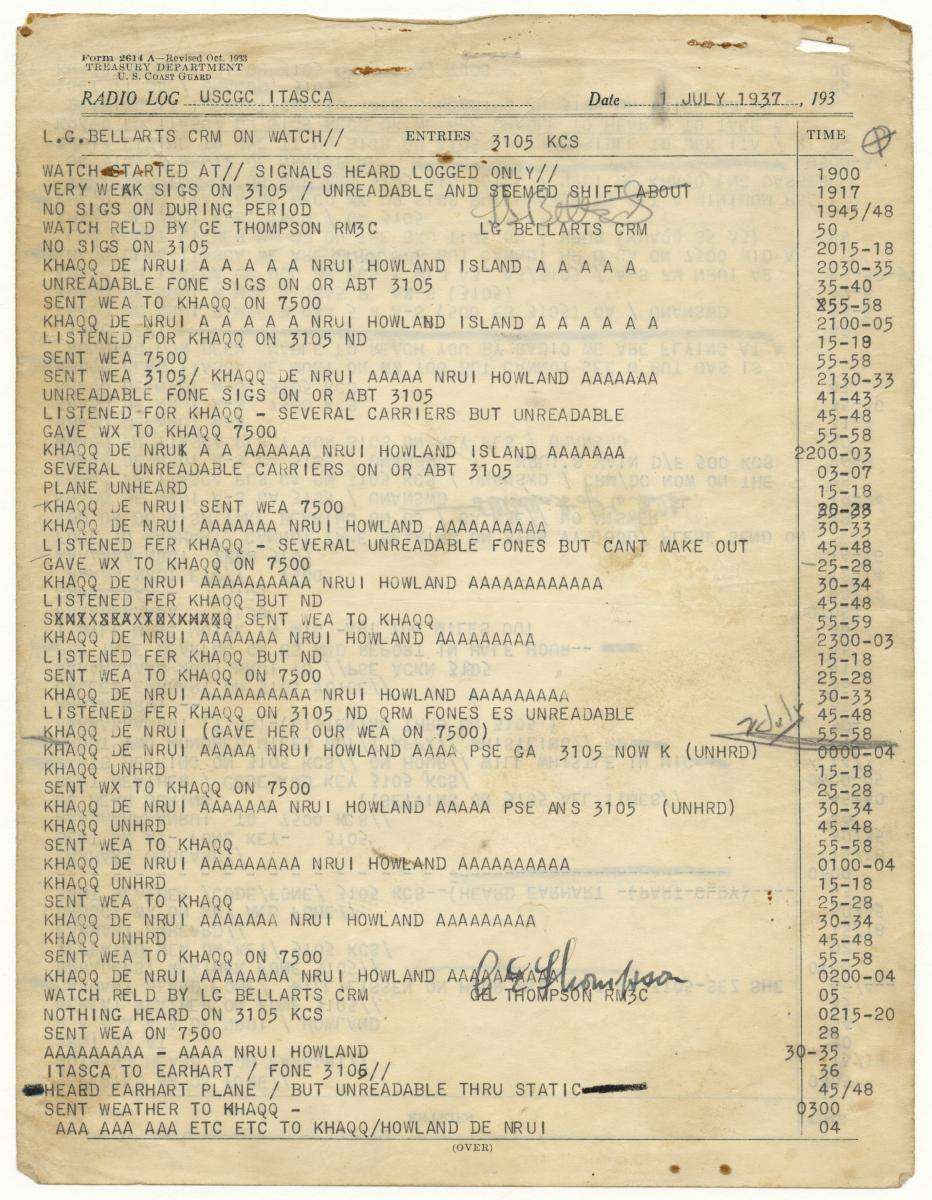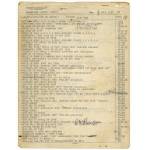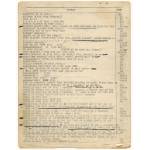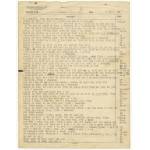Radio Log of the Last Communications of Amelia Earhart
7/1/1937 - 7/2/1937
Add to Favorites:
Add all page(s) of this document to activity:

Add only page 1 to activity:
Add only page 2 to activity:
Add only page 3 to activity:
Amelia Earhart and her navigator Fred J. Noonan disappeared during their attempt at a round-the-world flight in July 1937. This is the original radio log of Earhart's last communications with the U.S. Coast Guard cutter Itasca.
Earhart and Noonan took off on July 2 from Lae, New Guinea. They were headed for Howland Island, a dot two feet above sea level in the Pacific Ocean some 2,550 miles away. The U.S. Coast Guard cutter Itasca was stationed just offshore the island to provide radio navigation and communication support to Earhart. The cutter was in contact with the Earhart plane after it departed New Guinea and intermittently thereafter. Radio reception was poor, but at 6:14 a.m. on July 2 the plane reported its position as 200 miles away from Howland. Earhart contacted the Itasca at 7:42 a.m. indicating “We must be on you, but we cannot see you. Fuel is running low. Been unable to reach you by radio. We are flying at 1,000 feet.”
The ship tried to reply, but the plane seemed not to hear. Just before 8:00 a.m. the plane radioed they were circling and requested bearings. Earhart and Noonan reported they had received the cutter’s signals, but were unable to obtain a minimum for a bearing. At 8:43 a.m. the plane reported being on line 157-337 and running north and south with no reference point given. It was the last Itasca heard from Earhart and Noonan.
With no sign of the plane, it was assumed it had gone down. Itasca got under way at full speed to commence a search. On July 6, President Roosevelt expressed his concern for the safety of Earhart and that he was receiving frequent reports from the Navy Department on the progress of the search for her. He said he had ordered the search to cover as much territory as possible.
At Honolulu on July 18 the Navy announced it was giving up the hunt for Earhart. Naval authorities said the search had encompassed more than 250,000 square miles in every direction from Howland Island and that they believed they had exhausted every possible hope of finding Amelia Earhart and Fred Noonan.
Earhart and Noonan took off on July 2 from Lae, New Guinea. They were headed for Howland Island, a dot two feet above sea level in the Pacific Ocean some 2,550 miles away. The U.S. Coast Guard cutter Itasca was stationed just offshore the island to provide radio navigation and communication support to Earhart. The cutter was in contact with the Earhart plane after it departed New Guinea and intermittently thereafter. Radio reception was poor, but at 6:14 a.m. on July 2 the plane reported its position as 200 miles away from Howland. Earhart contacted the Itasca at 7:42 a.m. indicating “We must be on you, but we cannot see you. Fuel is running low. Been unable to reach you by radio. We are flying at 1,000 feet.”
The ship tried to reply, but the plane seemed not to hear. Just before 8:00 a.m. the plane radioed they were circling and requested bearings. Earhart and Noonan reported they had received the cutter’s signals, but were unable to obtain a minimum for a bearing. At 8:43 a.m. the plane reported being on line 157-337 and running north and south with no reference point given. It was the last Itasca heard from Earhart and Noonan.
With no sign of the plane, it was assumed it had gone down. Itasca got under way at full speed to commence a search. On July 6, President Roosevelt expressed his concern for the safety of Earhart and that he was receiving frequent reports from the Navy Department on the progress of the search for her. He said he had ordered the search to cover as much territory as possible.
At Honolulu on July 18 the Navy announced it was giving up the hunt for Earhart. Naval authorities said the search had encompassed more than 250,000 square miles in every direction from Howland Island and that they believed they had exhausted every possible hope of finding Amelia Earhart and Fred Noonan.
This primary source comes from the Collection BLRTS: Leo G. Bellarts Papers.
National Archives Identifier: 6210268
Full Citation: Radio Log of the Last Communications of Amelia Earhart; 7/1/1937 - 7/2/1937; Textual Materials Relating to the Last Flight and Disappearance of Amelia Earhart, 1937 - 1/31/1971; Collection BLRTS: Leo G. Bellarts Papers; National Archives at College Park, College Park, MD. [Online Version, https://www.docsteach.org/documents/document/earhart-radio-log, April 18, 2024]Rights: Public Domain, Free of Known Copyright Restrictions. Learn more on our privacy and legal page.






